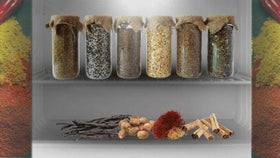Can You Grow Your Own Saffron
Growing Saffron in a Home Garden
Saffron can absolutely be grown for your own personal use. In fact, it’s actually pretty easy to do. That being the case, you might be wondering why it is the most expensive spice in the world. Plant cultivation isn’t actually the culprit of the high pricing, it’s actually primarily due to the process of harvesting.
Each Saffron flower only produces 3 stigmas each season (the part of saffron used for culinary and dying purposes) and they must be carefully removed by hand. It is incredibly labor-intensive and hard on the hands, back, and knees and it must be done quickly because they only bloom over the course of a 3-week period.
If that sounds like too much effort for you and you want to skip the growing and harvesting steps, we’ve got you covered with high-quality saffron grown around the world. If you still want to try growing and harvesting your own saffron, though, continue reading to learn how to grow your own Crocus Sativus!
How to Grow Saffron
Can saffron be cultivated?
Yes! In fact, you will likely never find a wild saffron crocus because this particular type of crocus (Crocus Sativus) actually contains three chromosomes, essentially making it sterile, so seeds are not spread by wind or animals like most wild plants. It is a hybrid, thought to have been propagated by humans, and because of this, even the bulbs are not found in the wild. To cultivate saffron, you actually need to start with corms, or bulbs, because their sterility ensures no seeds are produced.
What type of soil do you need to grow saffron?
Despite its dainty appearance, Crocus Sativus is actually a pretty hearty plant that is capable of growing in a wide breadth of soil types. That said, it does tend to prefer rich, organic soil, that is well-drained. Ph levels should be somewhere in the range of 6-8. If your soil is incredibly wet and not well-drained, the bulbs will likely develop mold and die. In incredibly moist environments, an above-ground garden box might be best for soil drainage. If you live in an incredibly dry environment, cultivation is still possible. Just make sure to water evenly.
What climate does saffron grow in
Saffron requires clear-cut seasons for best growth. Hot, dry summers and eventual cool nights of spring will trigger above-ground growth and blooming. Springs should have plenty of rain, or if not, frequent watering. Cold winter, will ensure the plant stays dormant until it is time to bloom again.
When to plant saffron:
Saffron will need to be planted about 6 weeks before a chance of frost. This will ensure they are able to acclimate to their new environment prior to entering the dormancy phase. If you live in an area with extreme dips in temperature in the winter, you may want to consider adding a layer of deep mulch or planting in containers and moving them out in the spring.
When should saffron be harvested?
The saffron plant will begin to bloom once the nights begin to cool off in the fall. They will typically begin to flower at night and open once the day begins to heat up. It is best to harvest the saffron flowers in the early morning to protect the reddish-orange stigmas until you strip them from the flower.
How to divide saffron bulbs:
As mentioned early in this article, saffron plants do not produce seeds. So to multiply your crop, you will need to divide the saffron corms. This is called grubbing. Saffron bulbs should be dug up every 4 or 5 years to pull the cormlets from the original bulb. You will know it’s time to pull up the bulbs when the leaves of the plant begin to wilt and turn brown. This means the plant is in hibernation and less likely to experience shock. Store the corms in a cool, dry place for planting in the spring.







Slofoodgroup
Author